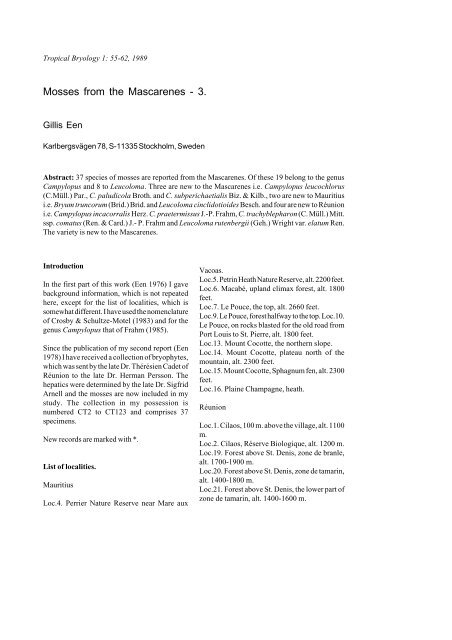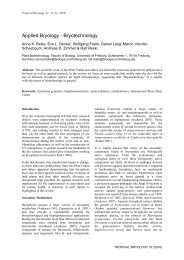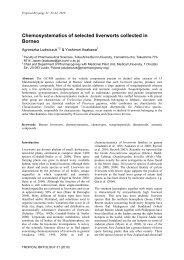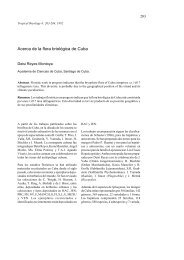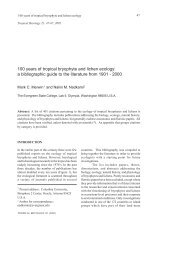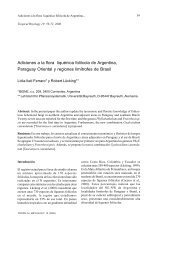Full text pdf - Tropical Bryology
Full text pdf - Tropical Bryology
Full text pdf - Tropical Bryology
Create successful ePaper yourself
Turn your PDF publications into a flip-book with our unique Google optimized e-Paper software.
<strong>Tropical</strong> <strong>Bryology</strong> 1: 55-62, 1989<br />
Mosses from the Mascarenes - 3.<br />
Gillis Een<br />
Karlbergsvägen 78, S-11335 Stockholm, Sweden<br />
Abstract: 37 species of mosses are reported from the Mascarenes. Of these 19 belong to the genus<br />
Campylopus and 8 to Leucoloma. Three are new to the Mascarenes i.e. Campylopus leucochlorus<br />
(C.Müll.) Par., C. paludicola Broth. and C. subperichaetialis Biz. & Kilb., two are new to Mauritius<br />
i.e. Bryum truncorum (Brid.) Brid. and Leucoloma cinclidotioides Besch. and four are new to Réunion<br />
i.e. Campylopus incacorralis Herz. C. praetermissus J.-P. Frahm, C. trachyblepharon (C. Müll.) Mitt.<br />
ssp. comatus (Ren. & Card.) J.- P. Frahm and Leucoloma rutenbergii (Geh.) Wright var. elatum Ren.<br />
The variety is new to the Mascarenes.<br />
Introduction<br />
In the first part of this work (Een 1976) I gave<br />
background information, which is not repeated<br />
here, except for the list of localities, which is<br />
somewhat different. I have used the nomenclature<br />
of Crosby & Schultze-Motel (1983) and for the<br />
genus Campylopus that of Frahm (1985).<br />
Since the publication of my second report (Een<br />
1978) I have received a collection of bryophytes,<br />
which was sent by the late Dr. Thérésien Cadet of<br />
Réunion to the late Dr. Herman Persson. The<br />
hepatics were determined by the late Dr. Sigfrid<br />
Arnell and the mosses are now included in my<br />
study. The collection in my possession is<br />
numbered CT2 to CT123 and comprises 37<br />
specimens.<br />
New records are marked with *.<br />
List of localities.<br />
Mauritius<br />
Loc.4. Perrier Nature Reserve near Mare aux<br />
Vacoas.<br />
Loc.5. Petrin Heath Nature Reserve, alt. 2200 feet.<br />
Loc.6. Macabé, upland climax forest, alt. 1800<br />
feet.<br />
Loc.7. Le Pouce, the top, alt. 2660 feet.<br />
Loc.9. Le Pouce, forest halfway to the top. Loc.10.<br />
Le Pouce, on rocks blasted for the old road from<br />
Port Louis to St. Pierre, alt. 1800 feet.<br />
Loc.13. Mount Cocotte, the northern slope.<br />
Loc.14. Mount Cocotte, plateau north of the<br />
mountain, alt. 2300 feet.<br />
Loc.15. Mount Cocotte, Sphagnum fen, alt. 2300<br />
feet.<br />
Loc.16. Plaine Champagne, heath.<br />
Réunion<br />
Loc.1. Cilaos, 100 m. above the village, alt. 1100<br />
m.<br />
Loc.2. Cilaos, Réserve Biologique, alt. 1200 m.<br />
Loc.19. Forest above St. Denis, zone de branle,<br />
alt. 1700-1900 m.<br />
Loc.20. Forest above St. Denis, zone de tamarin,<br />
alt. 1400-1800 m.<br />
Loc.21. Forest above St. Denis, the lower part of<br />
zone de tamarin, alt. 1400-1600 m.
56<br />
Loc.22. Forest above St. Denis, zone de bois de<br />
couleurs, alt. below 1500 m.<br />
Loc.23. Plaine des Cafres, alt. 1800 m.<br />
Loc.24. La Grande Montée, upper part.<br />
Loc.27. West of Plaine des Palmistes, wet forest<br />
with tree ferns.<br />
Loc.29. East of the volcano, on a lavabed from<br />
1932.<br />
Loc.30. Above St. Paul, alt. 2000 m., Forêt de<br />
Benard, alt. 1700- 2100 m.<br />
List of species<br />
Aerobryidium subpiligerum (Hampe) Card.<br />
Réunion: Le Tévelave (Bras-Sec), alt. 850 m., en<br />
sous bois clair, Cadet 20.7.1963 CT4 (Herb. Een<br />
R507).<br />
Anomobryum laceratum (Besch.) Broth.<br />
Réunion: Loc.2 (R396, R502, R503).<br />
My plants compare fairly well with the description<br />
by Bescherelle (1880:99), but I have not seen<br />
any lacerated leaves. R502 is 40 mm tall and has<br />
blunter leaves than the other two specimens.<br />
Blindia acuta (Hedw.) B.S.G.<br />
Réunion: Loc.1 (R520).<br />
Reported from Réunion by De Sloover<br />
(1979:393).<br />
Bryum erythrocaulon (Schwaegr.) Brid.<br />
Mauritius: Loc.6 (M409), on wood.<br />
The plant compares very well with the description<br />
given by Mohamed (1979:428-431), although<br />
I have not found any tubers. This plant has<br />
been seen by Ochi, who suggested it should be<br />
called B. billardieri Schwaegr., and I reported it<br />
under that name in my first report (Een 1976:214).<br />
* Bryum truncorum (Brid.) Brid.<br />
Mauritius: High Forest, on damp rocks, Vaughan<br />
M/52, det. Dixon (1937:123) as B. nanorrhodon<br />
C. Müll. (Herb. Een M229); Without locality or<br />
date, Vaughan M/126 (Herb. Een M468). -<br />
Réunion: Loc. 27 (R501).<br />
For my determinations I have used the monograph<br />
by Mohamed (1979). In no case have I been<br />
able to find any tubers. The Réunion plant<br />
compares well with the description of B.<br />
truncorum (Mohamed 1979:426-428). The<br />
Vaughan plant M/126 is much bigger but otherwise<br />
has the same characteristics. Macroscopically<br />
it looks like B. erythrocaulon but microscopically<br />
it shows a broad margin with sharp<br />
teeth in the upper part of the leaf and a flat margin<br />
in the lower part. Dixon (1937:123) called it B.<br />
nanorrhodon and referred to the comments by<br />
Renauld & Cardot (1915:297-298), who said that<br />
the margin is rather large with 3 to 5 rows of cells.<br />
This in turn leads to B. truncorum according to<br />
Mohamed (1979), who gives B. nanorrhodon as<br />
a synonym to B. erythrocaulon. Mohamed did<br />
not cite the works by Dixon or Renauld & Cardot.<br />
New to Mauritius but see Bescherelle (1880:97).<br />
Calyptrochaeta asplenioides (Brid.) Crosby<br />
Réunion: Piste forestière de la Plaine<br />
d’Affrouches, alt. 1200 m., sur sol très humide,<br />
incliné, et couvert par des Hedychium, localité 7,<br />
Cadet 29.1.1964 CT67 (Herb. Een R516).<br />
Campylopus Brid.<br />
In dealing with this difficult genus I have followed<br />
Frahm (1985) in a rather uncritical manner.<br />
I have used a small desk top computer for this part<br />
of the work, with input also from De Sloover<br />
(1982), Gradstein & Sipman (1978), Nyholm<br />
(1987), Renauld & Cardot (1915) and Smith<br />
(1978). My methods and conclusions have been<br />
published elsewhere (Een 1988A). A complete<br />
record of all my primary data has been deposited<br />
in the IAB software library (Een 1988B).<br />
Anybody who is interested in knowing more<br />
about this is welcome to contact me.<br />
Campylopus aureonitens (C. Müll.) Jaeg.<br />
Réunion: Loc. 29 (R546).<br />
My determination of this specimen is based on its<br />
dark colour and small ventral cells as seen in a<br />
section across the nerve. Fertile stems have very<br />
pronounced “heads”. On the other hand the tips<br />
of the leaves do not bend outwards as described<br />
by Frahm (1985:25). The plant has sporophytes.<br />
Campylopus aureus Bosch. & Lac.<br />
Réunion: Loc. 19 (R534).<br />
The specimen is typical in every respect including<br />
the golden brown colour.
Campylopus cambouei Ren. & Card.<br />
Mauritius: Loc. 4 (M486); 13 (M281).<br />
Both specimens have previously been determined<br />
as C. arctocarpus ssp. madecassus by<br />
Bizot (1968:472) and myself, partly on the basis<br />
of the presence of flagellae/gemmae. A distinguishing<br />
characteristic according to Frahm<br />
(1985:47), is the thin walls of the cells in the lower<br />
part of the lamina. A disturbing fact however is<br />
that the picture of C. cambouei (Frahm<br />
1985:46:e) shows thicker cell walls than the<br />
picture of C. arctocarpus (Frahm 1985:17:e).<br />
Campylopus crateris Besch.<br />
Réunion: Loc. 19 (R530)<br />
The specimen matches the description given by<br />
Frahm (1985:60), but the back of the nerve is<br />
slightly ridged (1/2 cell high).<br />
Campylopus flexuosus (Hedw.) Brid.<br />
Mauritius: Sine loco, 1876 Robillard, det.<br />
Renauld? as C. brachymastyx C. Müll.,(S), Frahm<br />
(1985:80); Sine loco, 1890 Rodriguez, det.<br />
Renauld? as C. virescens Besch., (S), Frahm<br />
(1985:80). - Réunion: Loc. 1 (R521); 2 (R527);<br />
19 (R529, R535); 30 (R554); Plaine des<br />
Grègues?, 1889? Rodriguez, det. Renauld? as C.<br />
virescens, (S, ex herb. Renauld, Musci Masc.-<br />
Madag. 104?).<br />
The section of the nerve shows ventral cells that<br />
are smaller than the median cells and usually<br />
more numerous. The cells in the lower part of the<br />
leaf have thick walls, which sometimes are<br />
slightly uneven. Gemmae have been seen in one<br />
of the specimens (R527). R529 has formed very<br />
compact cushions. R554 is a rather tall and pale<br />
plant with sporophytes. The leaves have long fine<br />
points with a few pale teeth and a serrate margin<br />
rather far down the lamina.<br />
Campylopus fragilis (Brid.) B.S.G.<br />
Réunion: Loc. 1 (R522).<br />
* Campylopus incacorralis Herz.<br />
Réunion: Loc. 20 (R539).<br />
The section of the nerve shows ventral cells that<br />
are smaller than the median cells and usually<br />
twice as many. Furthermore the cells in the base<br />
of the leaf near the nerve have thick and porous<br />
walls. The first of these characteristics agrees with<br />
the <strong>text</strong> of Frahm (1985:96) but not with the<br />
picture (1985:95), which is drawn from the type<br />
of C. subperichaetialis Biz. & Kilb. On the other<br />
hand there is a good fit with the picture of the<br />
closely related species C. flexuosus (Frahm<br />
1985:77). Is C. subperichaetialis really a synonym?<br />
My specimen has gemmae as in C.<br />
flexuosus. New to Réunion.<br />
Campylopus jamesonii (Hook.) Jaeg.<br />
Réunion: Loc. 20 (R538).<br />
The plant fits well with the description in Frahm<br />
(1985:102).<br />
Campylopus julaceus Jaeg. ssp. arbogastii<br />
(Ren.& Card.) J.-P. Frahm<br />
Mauritius: Loc. 5 (M489). - Réunion: Loc. 1<br />
(R524); 2 (R562); 19 (R532); 30 (R550, R551);<br />
Le Tévelave (Bras Sec), alt. 800 m., en plein terre<br />
dans un bois clair, 1963 Cadet CT6 (Herb. Een<br />
R560).<br />
This species is close to C. pilifer in leaf structure.<br />
As distinguishing characteristics I have used the<br />
appressed leaves and the nodulose habitus,<br />
which give this species a rather special appearance<br />
(var. capitulifer Ren. & Card.). All my<br />
specimens are straw-coloured and rather pale.<br />
The border between the thin-walled cells in the<br />
base of the leaf and the thick-walled cells further<br />
up is very sharp and situated in the upper part of<br />
the leaf which gives it a Tortella-like appearance.<br />
The lamellae on the back of the nerve are often up<br />
to 3 cells high in the upper part of the leaf. R550<br />
is not typical in the sense that I have found leaves<br />
with clearly differentiated alar cells. Some of my<br />
specimens have sporophytes (R532, R550 and<br />
R551) which is new according to Frahm<br />
(1985:111).<br />
* Campylopus leucochlorus (C. Müll.) Par.<br />
Réunion: Loc. 19 (R330); 23 (R540).<br />
R540 fits well with the description by Bizot &<br />
Kilbertus (1979:85) and Frahm (1985:115-117).<br />
This species is close to C. nivalis, something<br />
which Frahm has failed to point out. He separates<br />
the two species in the key (1985:13) by the shape<br />
of the cells in the upper part of the lamina. As<br />
another distinguishing characteristic I have used<br />
the fact that this species has large, hyaline alar<br />
57
58<br />
cells. R330 contains a few small stems scattered<br />
among Bryum argenteum and Ceratodon<br />
purpureus, and thus the determination is far from<br />
certain and of limited value. New to the<br />
Mascarenes.<br />
* Campylopus paludicola Broth.<br />
Réunion: Loc. 30 (549).<br />
The plant compares well with the description in<br />
Frahm (1985:134) except for the alar cells, which<br />
in my case are not very distinct. It has plenty of<br />
sporophytes. New to the Mascarenes.<br />
Campylopus perichaetialis P.Varde & Thér.<br />
Réunion: Loc. 19 (R528).<br />
This species is very close to C. nivalis. As<br />
distinguishing characteristics I have used leaf<br />
points with no or very few teeth and somewhat<br />
shorter and broader cells in the base of the lamina<br />
(Ratio 2.9 compared with 6.0 in C. nivalis<br />
according to Frahm (1985:125+136)).<br />
Campylopus pilifer Brid.<br />
Mauritius: Loc. 7 (M412, M490, M491); 10<br />
(M459, M492); Pioneer species on bare laterite in<br />
the uplands, 1935 Vaughan M/60, det. Dixon<br />
(1937:123) as C. introflexus Hedw. var. mauritianus<br />
Dix. (Herb. Een M231). - Réunion: Loc. 1<br />
(R185, R523); 2 (R477, R526); 19 (R536); 29<br />
(R547); 30 (395, R552, R553, R556, R557,<br />
R561).<br />
The leaves of this species are very similar to those<br />
of C. julaceus ssp. arbogastii but the lamellae at<br />
the back of the nerve tend to be more than 3 cells<br />
high. Furthermore the stems are evenly thick and<br />
without nodes. Two specimens, i.e. M491 and<br />
R561 show rather low lamellae (not more than 2<br />
cells high) and could thus be referred to the old<br />
species C. brevirameus Dix. Compare with Frahm<br />
(1985:149). I have seen clearly differentiated alar<br />
cells in 5 specimens (M412, M491, R395, R477<br />
and R526). Three of my specimens (R556, R557<br />
and R561) show some leaves with a strongly<br />
squarrose hair point, but the leaf shape is that of<br />
the present species (Frahm 1985:144) and not of<br />
C. introflexus (Hedw.) Brid. (Frahm 1985:98). A<br />
confusing fact here is that Smith (1978:184)<br />
illustrates the shape of the leaves of the two<br />
species in a reversed fashion! For further<br />
information on these two species see Frahm<br />
(1974), Gradstein & Sipman (1978) and Magill<br />
(1981).<br />
* Campylopus praetermissus J.-P. Frahm<br />
Réunion: Loc. 21 (R541).<br />
The plant compares fairly well with the original<br />
description given by Frahm (1985:152), although<br />
the alar cells are coloured and not hyaline.<br />
This species seems to have many characters in<br />
common with C. flexuosus a fact which was not<br />
indicated by Frahm. The distinguishing<br />
characteristic according to the key (Frahm<br />
1985:15) is that in this species the back of the<br />
nerve is smooth while it is ridged in C. flexuosus.<br />
My plant has sporophytes. New to Réunion.<br />
Campylopus pseudobicolor C. Müll.<br />
Mauritius: Loc. 14 (M493).<br />
My computer suggested this species on the basis<br />
of large ventral cells of the nerve, lamellae 1-2<br />
cells high on the back of the nerve, clearly<br />
differentiated alar cells and cells with thin walls<br />
in the lower part of the lamina. The use of the key<br />
in Frahm (1985:13) led to C. hildebrandtii. I am<br />
not happy with this determination. My plant is 40<br />
to 50 mm. tall, light green with a red tomentum<br />
and looks like a cross between the two species.<br />
Thus I am not suggesting here that C.<br />
pseudobicolor is new to the Mascarenes.<br />
Campylopus robillardei Besch.<br />
Mauritius: Loc. 5 (M488); 16 (M495, M497);<br />
Chemin Cheval near Grand Bassin, 1933<br />
Vaughan M/45, det. Dixon (1937:122), (Herb.<br />
Een M223); Petrin heath vegetation, at base of<br />
trees and on clay paths under shade, alt. 2150 feet,<br />
rainfall 160 inches, 1962 Vaughan M/116 (Herb.<br />
Een M498, M499); Base of trees near Petrin, 1962<br />
Vaughan M/122 (Herb. Een M500). - Réunion:<br />
Loc. 23 (R174).<br />
The <strong>text</strong> in Frahm (1985:165) differs from the<br />
picture (1985:166) in several respects. After some<br />
hesitation I have used the picture for my<br />
determination. Thus the width of the nerve<br />
should be about 2/3 of that of the lamina and the<br />
back of the nerve has lamellae 1-2 cells high.<br />
M500 is different in being rather light yellow and<br />
in having terminal 'heads'. M495 and M497 are<br />
probably identical but rather different from the<br />
other specimens. They are much larger, somewhat
nodulose and have plenty of reddish tomentum.<br />
Is this C. gallienii Par.? Frahm (1985:164) has<br />
gallieni as a new synonym but there is no<br />
indication that he has seen it (1985:168). I have<br />
used a description in Renauld & Cardot<br />
(1915:105-106 + Pl. 24A). I hesitate including<br />
R174. Bizot (1968:472) named it C. capitiflorus<br />
Mont. (= C. arcuatus (Brid.) Jaeg.) but the nerve<br />
section shows ventral cells which are equal to or<br />
larger than the median cells in size. On the other<br />
hand I have not seen ridges at the back of the<br />
nerve.<br />
Campylopus stenopelma (C.Müll.) Par.<br />
Réunion: Loc. 24 (R543).<br />
I have named this specimen on the basis of the<br />
cells in the lower part of the leaf near the nerve<br />
being very uneven with porous walls and the cells<br />
near the margin being linear with a small lumen,<br />
forming a rather distinct border. Compare Frahm<br />
(1985:181) and Magill (1981:141-143). The<br />
species seems to be new to Réunion but has been<br />
recorded before from Mauritius under the name C.<br />
chlorotrichus (C.Müll.) Par. (Melvill 1888:101).<br />
* Campylopus subperichaetialis Biz. & Kilb.<br />
Réunion: Loc. 1 (R370); 30 (R555). - Tanzania:<br />
Morogoro district. Uluguru Mts. On the top of<br />
Bondwa Peak, alt. 1950-2100 m. On the ground<br />
in subalpine heath. Leg. Pócs & Gibbon 1969-10-<br />
12. Det. Bizot. Isotype. (SEM 2879, herb.Een<br />
T034).<br />
The plants match well the description given by<br />
Bizot & Kilbertus (1979:75-76) and the isotype.<br />
A section through the nerve shows ventral cells of<br />
more or less the same size and type as the median<br />
cells. The cells in the lower part of the lamina have<br />
smooth walls. Frahm (1985:94) has reduced this<br />
species to a synonym to C. incacorralis, but see<br />
my comments under that species. New to the<br />
Mascarenes at least under this name.<br />
* Campylopus trachyblepharon (C.Müll.) Mitt.<br />
ssp. comatus (Ren. & Card.) Frahm<br />
Mauritius: Loc. 5 (M487); 15 (M252); 16<br />
(M494); Mare aux Vacoas, at base of trees, 1933<br />
Vaughan M/43, det. Dixon (1937:43) as C.<br />
capitiflorus Mont. (Herb. Een M221); In the<br />
uplands, forming dense clumps under trees, 1936<br />
Vaughan M/95, det. Dixon as C. 'Robillardi’<br />
(Herb. Een M244). - Réunion: Loc. 2 (R525); 19<br />
(R531, R533); 23 (R542); Le Tévelave (Bras<br />
Sec), alt. 800 m., en pleine terre dans un bois clair,<br />
1963 Cadet CT6 (Herb. Een R559). - Madagascar:<br />
île Sainte-Marie, sur l’humus, 1891 Arbogast,<br />
det. Renauld (1891:290) as C. comatus Ren. &<br />
Card. (S, ex herb. Renauld, Musci Masc.-Madag.<br />
no. 55); Prope pagum Lohomby, ad arb. 'Kimba'<br />
dictam, inter Cladonias, c. 1200 m. alt., 1904<br />
Salvan, det. Paris (1905:52) as C. comatus (S, ex<br />
herb. E.G. Paris).<br />
Most of my plants are clearly nodulose and the<br />
cells in the base of the leaf near the nerve have<br />
thick and porose walls. M244 is of special interest<br />
as it was determined by Dixon as C. robillardei<br />
but is not the specimen referred to in his paper<br />
(Dixon 1937:122). He was uncertain about it and<br />
so am I. I find that the cells in the lower part of the<br />
lamina near the nerve have thick walls, but these<br />
are not porous although somewhat uneven.<br />
Furthermore I have seen flagellae/gemmae in the<br />
heads of the clearly nodulose plant. R531 and<br />
R533 are two samples from the same locality and<br />
probably identical. They are different in not<br />
being comate and in having longer cells (50-80<br />
microns, compared with 20-48 in Frahm<br />
1985:189) in the lower part of the lamina with<br />
thin walls and large triangles in the corners (i.e.<br />
not thick porous walls). Also R559 differs from<br />
the description in Frahm (1985:189). It is a large<br />
plant, slightly comate, yellowish and with long<br />
silky leaves which are more than 7 mm. long. All<br />
previous reports such as Bizot (1968:472) and<br />
Frahm (1985:191) refer to Mauritius. Thus the<br />
species is new to Réunion.<br />
Dicranoloma billardieri (Brid.) Par.<br />
Réunion: Loc. 19 (R491); 20 (R492); 22 (R493);<br />
27 (R188, R496); Cirque de Cilaos, De Sloover<br />
22.12.1973 no. 17641 (S).<br />
Bizot (1968:472) determined my plant R188 as<br />
var. scopareolum (C. Müll.) Thér. It has however<br />
dicranoid leaves with many teeth at or near the<br />
point. The variety has orthophyllous leaves with<br />
practically no teeth as described by Renauld<br />
(1897:62). I have taken the spelling of the name<br />
from a recent monograph by Tan & Koponen<br />
(1983:329-331).<br />
Homaliodendron exiguum (Bosch & Lac.)<br />
59
60<br />
Fleisch.<br />
Réunion: Les Avirons (Oratoire de Lourdes), alt.<br />
400 m., surface rocheuse verticale à l’ombre,<br />
Cadet 3.8.1963 CT19 (Herb. Een R515).<br />
Hypopterygium laricinum (Hook.) Brid.<br />
Réunion: Les Avirons (Oratoire de Lourdes), alt.<br />
400 m., surface rocheuse très irrégulière sous<br />
ombrage légèr, Cadet 3.8.1963 CT18 (Herb. Een<br />
R511); Piste forestière de la Plaine d’Affouche,<br />
alt. 1200 m., sur sol humide, sous Hedychium,<br />
forme des tufs volcanique, tapis denses, localité<br />
7, Cadet 29.1.1964 CT76 (Herb. Een R512).<br />
Regarding the name of this plant I refer to<br />
previous comments (Een 1978:220).<br />
Leucoloma bifidum (Brid.) Brid.<br />
Mauritius: Sine loco (S, ex herb. Kew). - Réunion:<br />
Loc. 1 (R490); Grand Brûlé (Voisinage de la route<br />
N1), alt. 120 m., sur tronc mort, dans une clairière<br />
de la forêt, Cadet 5.1.1964 CT31 (Herb. Een<br />
R513).<br />
The Cadet plant has sparse dichotomous branchings<br />
and the simple stems are up to 100 mm. long.<br />
* Leucoloma cinclidotioides Besch.<br />
Mauritius: Loc. 4 (M480).<br />
I have not seen other specimens of this species.<br />
My plant compares well with the descriptions<br />
given by Bescherelle (1880:22-23) and Renauld<br />
(1897:68) but it lacks the denticulation in the tip<br />
of the leaf mentioned by Bescherelle. New to<br />
Mauritius.<br />
Leucoloma crepinii Ren. & Card.<br />
Mauritius: Loc. 5 (M479); 7 (M482); 9 (M483);<br />
10 (M484). - Madagascar: Silva Fito, distr.<br />
Tamatave, leg. Perrot July 1897, det. Renauld<br />
n.24 (S, ex herb. Levier).<br />
M484 is a somewhat bigger plant and the intermediate<br />
cells ('cellule intermediaires' Renauld<br />
1909:6) adjacent to the chlorophyllose cells<br />
towards the top of the leaf have clearly porous<br />
longitudinal walls.<br />
Leucoloma dichelymoides (C. Müll.) Jaeg.<br />
Mauritius: Loc. 5 (M403, M481); Petrin on<br />
Phillipia heath, leg. Vaughan M/94, det. Dixon<br />
(1937:122)(Herb. Een M243). - Madagascar:<br />
Montagne d’Ambre, leg. De la Bathie Sept. 1926,<br />
det. Thériot (1929:107)(S, ex herb. Thériot).<br />
My plants come from the same locality as the<br />
Vaughan plant. They differ from the latter and<br />
from the description in Renauld (1897:86-87) in<br />
the following details: The internal cells have<br />
thicker walls and dorsal papillae are more<br />
obvious, the intermediary cells are narrower but<br />
have thicker walls, the leaf point is not flexuose<br />
and has only small distant blunt teeth, the alar<br />
group is separated from the nerve and the nerve is<br />
broader - 50 microns versus 35.<br />
Leucoloma fuscifolium Besch.<br />
Réunion: Le Tévelave (Bras-Sec), alt. 800 m., sur<br />
rocher, en sous bois obscur, Cadet 20.7.1963 CT7<br />
(Herb. Een R500). - Madagascar: Versant<br />
oriental, leg. Girod-Genet 1900 (S, ex herb.<br />
Renauld) (Renauld & Cardot 1915:97).<br />
The Cadet plant is much bigger than the Madagascar<br />
one. The leaves are 11 mm. long as<br />
compared with 6.2 mm.<br />
Leucoloma longifolium (Brid.) Wijk & Marg.<br />
Mauritius: Loc. 4 (M478); 13 (M485). - Réunion:<br />
Piste forestière de la Plaine d’Affouches, alt. 1200<br />
m., sur sol très humid, incliné, et couvert par des<br />
Hedychium, localité 7, Cadet CT91 29.01.1964<br />
(Herb. Een R499); Leg. Rodriguez (S, ex herb.<br />
Cardot).<br />
I have studied M478 in more detail than the other.<br />
It compares well with the description by Renauld<br />
(1897:81-82). The leaves are long (about 11 mm)<br />
which indicates var setifolium (Besch.) Wijk &<br />
Marg., but on the other hand the stems are short<br />
(max. 2 cm. and not 4 cm). The pale margin is 10<br />
microns wide and is composed of 2 (or 3) cells,<br />
which indicates L. capillifolium Ren. rather than<br />
L. longifolium (Renauld 1897:85-86). I have not<br />
seen L. capillifolium.<br />
Leucoloma mafatense Ren.<br />
Réunion: Loc. 23 (R495).<br />
I have not seen any other specimen of this species<br />
but my plant compares well with the description<br />
given by Renauld (1897:66).<br />
* Leucoloma rutenbergii (Geh.) Wright * var.<br />
elatum Ren.<br />
Réunion: Grand Brûlé (près route N1), alt. 100 m.,<br />
base d’un tronc de Aguaria près du sol, Cadet
5.1.1964 CT45 (Herb. Een R498). - Madagascar:<br />
Territoire Sakalave, Cercle de Maintirano,<br />
récoltées par les tirailleurs sakalave 1901 (Paris<br />
1902:77)(S, ex herb. E.G.Paris).<br />
The Cadet plant as well as that from Madagascar<br />
has a nerve which is 70 microns broad at the base.<br />
Renauld (1897:84) says 90-105 micrones.<br />
Macroscopically the Cadet plant CT45 is rather<br />
like CT7, which I have called L. fuscifolium. The<br />
former has tall papillae on the dorsal upper part of<br />
the leaf and these papillae are often bent towards<br />
the tip of the leaf. CT7 has no papillae. The<br />
species is new to Réunion and the variety is new<br />
to the Mascarenes.<br />
Racopilum mauritianum Besch.<br />
Réunion: Les Avirons (Oratoire de Lourdes), alt.<br />
400 m., à la base d’un rocher, près du sol, lieu à<br />
demi-ombragé, Cadet 3.8.1963 CT17 (Herb. Een<br />
R508); Les Avirons, sur sol humide, à l’ombre<br />
d’un rocher, Cadet 3.8.1963 CT20 (Herb. Een<br />
R509); Les Avirons, surface rocheuse irrégulière<br />
retenant l’humus, Cadet 3.8.1963 CT28 (Herb.<br />
Een R510).<br />
I have used the same distinguishing characteristics<br />
as before (Een 1978:221).<br />
Acknowledgement<br />
I wish to thank Mr. Thor-Björn Engelmark for<br />
help with the genera Dicranoloma and Leucoloma.<br />
References<br />
Bescherelle, E. 1880. Florule Bryologique de la Réunion,<br />
de Maurice et des autres îles austro-africaines de l’o<br />
céan indien. - Paris.<br />
Bizot, M. 1968. Mousses récoltées par Mr. Gillis Een dans<br />
les îles Maurice et de la Réunion. - Svensk Bot. Tidskr.<br />
62:471- 481.<br />
Bizot, M. & Kilbertus G. 1979. Les Campylopus<br />
africains subg. Lucidus Biz. et Kilb. - Rev. Bryol. Lichénol.<br />
45:61-95.<br />
Crosby, M.R. 1976. Trois mousses (Hookeriacées) nou<br />
velles pour la flore Malgache. - Rev. Bryol. Lichénol.<br />
42:711-714.<br />
Crosby, M.R., Schultze-Motel, Ute & Schultze-<br />
Motel W. 1983. Katalog der Laubmoose von Madagaskar<br />
und denumliegenden Inseln. - Willdenowia 13:187-255.<br />
De Sloover, J.L. 1979. Note de bryologie africaine 10. -<br />
Blindia, Pilopogon, Bryoerythrophyllum, Orthodont<br />
ium, Orthostichidium, Oligotrichum. - Bull. Jard. Bot.<br />
Natl. Belg. 49:393-408.<br />
De Sloover, J.L. 1982. Note de bryologie africaine 11. -<br />
Campylopus subgen. Pseudocampylopus. - Bull. Jard.<br />
Bot. Natl. Belg. 52:95-113.<br />
Dixon, H.N. 1937. Mosses collected in Mauritius by Dr.<br />
R.E. Vaughan. - Rev. Bryol. Lichénol. 10:121-127.<br />
Een, K.G. 1976. Mosses from the Mascarenes. - Lindbergia<br />
3:213- 217.<br />
Een, K.G. 1978. Mosses from the Mascarenes - 2. - Lind<br />
bergia 4:219-223.<br />
Een, K.G. 1988A. Computer assisted moss determination. -<br />
Bryological Times 48:1+4-5.<br />
Een, K.G. 1988B. Catalogue of characters for all Campy<br />
lopus species of AFR 3 in a dBase version provided by<br />
B.J. O’Shea. - IAB software library diskette no. 120.<br />
Frahm, J.-P. 1974. Zur Unterscheidung und Verbreitung<br />
von Campylopus introflexus (Hedw.) Brid. und C. poly<br />
trichoides De Not. - Rev. Bryol. Lichénol. 40:33-44.<br />
Frahm, J.-P. 1985. Afrikanische Campylopus-Arten (Di<br />
cranaceae, Musci). - Bryophytorum Bibliotheca, Band<br />
31.<br />
Gradstein, S.R. & Sipman, H.J.M. 1978. Taxonomy and<br />
World Distribution of Campylopus introflexus and C.<br />
pilifer (= C. polytrichoides): A New Synthesis. - The<br />
Bryologist 81:114-121.<br />
Magill, R. E. 1981. Flora of Southern Africa, Bryophyta,<br />
Part 1 Mosses, Fascicle 1, Sphagnaceae - Grimmiaceae. -<br />
Pretoria.<br />
Melvill, J.Cosmo. 1888. Notes on a Small Collection of<br />
Mosses from Mauritius. - Mem. Proc. Manchester Lit.<br />
Phil. Soc. (1896) ser.4, 1:100-103.<br />
Mohamed, M.A.H. 1979. A taxonomic study of Bryum<br />
billardieri Schwaegr. and related species. - J. Bryol.<br />
10:401-465.<br />
Nyholm, E. 1987. Illustrated Flora of Nordic Mosses, Fasc.<br />
1. Fissidentaceae - Seligeriaceae. - Odense.<br />
Paris, E.G. 1902. Muscinées de Madagascar (3:e article).<br />
- Rev. Bryol. 29:76-86.<br />
Paris, E.G. 1905. Muscinées de Madagascar (5:e article).<br />
- Rev. Bryol. 32:51-53.<br />
Renauld, F. 1891. Notes bryologiques sur les îles austroafricaines.<br />
- Revue de Botanique, Bulletin mensuel de la<br />
Société Française de Botanique 9:289-291+393-401.<br />
Renauld, F. 1897. Prodrome de la flore bryologique de<br />
Madagascar, des Mascareignes et des Comores. - Mona<br />
co.<br />
Renauld, F. 1909. Essai sur les Leucoloma et supplément<br />
au prodrome de la flore bryologique de Madagascar, des<br />
Mascareignes et des Comores. - Monaco.<br />
Renauld, F. & Cardot, J. 1915. Histoire naturelle des<br />
plantes, Mousses. - In: Vol. 39 of Grandidier, A. & G.<br />
(eds), Histoire physique, naturelle et politique de Mada<br />
gascar, Paris.<br />
Smith, A.J.E. 1978. The moss flora of Britain and Ireland.<br />
- Cambridge.<br />
Tan, B.C. & Koponen, T. 1983. Dicranoloma (Musci,<br />
Dicranaceae) in Southeast Asia, with special reference<br />
to the Philippine taxa. - Ann. Bot. Fennici 20:317-334.<br />
Thériot, I. 1929. Septième contribution à la flore bryolo<br />
gique de Madagascar. - Recueil Publ. Soc. Havraise Et.<br />
Div. 96:99- 121.<br />
61


